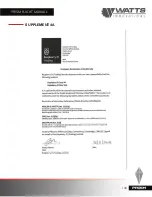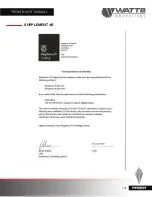
PRISM FLIGHT MANUAL
133
In the Event of Over-Discharge of a Battery Pack (Low Voltage during flight), the pack
should be removed from duty until it can be determined if any significant damage was
inflicted to the internal cell chemistry. If the Voltage dropped below 3 V per cell under load,
irreversible damage would have occurred. The extent of this damage must be determined
before the pack can be used again.
Over Discharge will result in an abnormally warm and swollen battery pack and should be
dealt with in the following manner:
• Let the pack rest long enough for the cells to return to normal temperature.
• Connect the pack to the battery charger and log the individual cell voltages, individual
cell internal resistance and overall pack voltage.
• Charge the pack at a low c rate (0.2 C) to minimize any damage caused by the over
discharge.
• Once the charge has completed, log the individual cell voltages, individual cell internal
resistance and the total amount of charge that went into the pack.
Observations
• Observe the individual cell voltages are all similar
• Observe the Internal resistance of each cell is within acceptable level (less than 10 m
Ω
)
• Determine what percentage of the battery capacity was used
Test
• Discharge the battery through the charger at 4 amps to 3.3 V per cell under load
• The cells should measure 3.7 V each when the discharge is complete
• Calculate the percentage of total battery capacity used during the test
• The percentage used should be roughly 80% of the total capacity
• If the percentage used is higher than 90% then the pack has suffered irreversible
damage and should not be used for flight operations
10.8.3 UNSCHEDULED MAINTENANCE
Summary of Contents for PRISM R.P.A.S.
Page 3: ...PRISM FLIGHT MANUAL 3 INTENTIONALLY LEFT BLANK...
Page 5: ...PRISM FLIGHT MANUAL 5 INTENTIONALLY LEFT BLANK...
Page 7: ...PRISM FLIGHT MANUAL 7 INTENTIONALLY LEFT BLANK...
Page 18: ...PRISM FLIGHT MANUAL 18 Figures 5 6 PRISM PAYLOAD AND FLIGHT TIME CALCULATIONS...
Page 21: ...PRISM FLIGHT MANUAL 21 Figure 7 RPA ORIENTATION DURING TAKEOFF LANDING...
Page 47: ...PRISM FLIGHT MANUAL 47 Figure 8 PRISM POWER CIRCUIT DIAGRAM...
Page 53: ...PRISM FLIGHT MANUAL 53...
Page 54: ...PRISM FLIGHT MANUAL 54...
Page 57: ...PRISM FLIGHT MANUAL 57 Figure 14 20 WATTSQGC APPLICATION SETTINGS GENERAL...
Page 67: ...PRISM FLIGHT MANUAL 67 Figure 31 COMPASS CALIBRATION SCREEN...
Page 81: ...PRISM FLIGHT MANUAL 81 Figure 46 47 USER SELECTABLE TELEMETRY VALUES FOR HUD...
Page 84: ...PRISM FLIGHT MANUAL 84 Figure 50 51 WATTSQGC PRE FLIGHT CHECKLIST...
Page 103: ...PRISM FLIGHT MANUAL 103 Assembled battery pack Smaller battery assembly Assembled battery pack...
Page 106: ...PRISM FLIGHT MANUAL 106 Battery Packs Top Mounted Battery Packs Bottom Mounted...
Page 136: ...PRISM FLIGHT MANUAL 136 SUPPLEMENT 1...
Page 137: ...PRISM FLIGHT MANUAL 137 SUPPLEMENT 2A...
Page 138: ...PRISM FLIGHT MANUAL 138 SUPPLEMENT 2B...
Page 139: ...PRISM FLIGHT MANUAL 139 SUPPLEMENT 3...





























